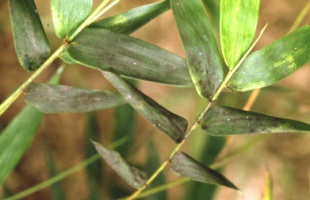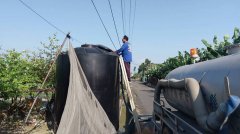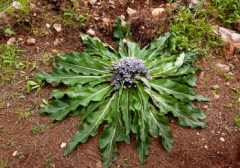Four common diseases and insect pests of bamboo are introduced, and the causes and symptoms of bamboo diseases and insect pests are explained.
There are many diseases of bamboo. What kind of diseases and insect pests do you know? Let's take a look at the following common diseases and insect pests. What kind of disease is it?
1. Rust disease
Pathogen: Dasturelle divina
British name: anti-rust
Common name: red mushroom
Bamboo rust is a disease caused by fungi, which occurs only in bamboo leaves and leaf sheaths, forming many brown spots on the leaves at the initial stage, and then gradually raised on the back of the leaves, showing spindle-shaped or hemispherical, yellow-brown or rust-like prominent spots with powdery surface. this is the summer cell pile and summer cell seed of the pathogen, and the diseased leaves are easy to dry up and fall off. At the later stage of the disease, the plaque will form a dark-brown, hard and slightly raised pile of winter cells, and it is difficult to find winter children of sexual generations in the fields of Taiwan.
Rust can occur in all seasons of the year, but there is a difference in severity in different seasons. it becomes more and more serious in July and reaches its peak around October. The leaves were dispersed by Rain Water or the wind, and landed on the uninfected site, if the temperature was suitable (20: 30 ℃), coupled with moist leaves, the seeds were easy to germinate and invade the leaf tissue, resulting in repeated infection and re-production of summer seeds, which lasted about 7 days and 10 days from invasion to production. The leaves near the base of the same branch were exposed to the atmosphere for a long time, the disease was more serious, and the heart leaves decreased slightly. New leaves begin to grow in spring of the year, and because the temperature and humidity are suitable, the disease spots remaining on the leaves begin to produce summer cells and cause repeated infection. The new leaves continue to grow during spring and summer, and the rust does not look too serious. After the beginning of autumn, the growth potential of bamboo plants weakened and the temperature and humidity were suitable for the disease, so that the leaves grown in summer were quickly infected and began to fall, showing the severity of the disease. Because it is easy to occur in the environment of muggy, humid and poor ventilation, as long as we pay attention to the cultivation and management, it is not necessary to use chemical control.
2. Bamboo bacterial wilt
Pathogenic bacteria: Erwinia sinocalami
British name: bacterial Fusarium wilt
Common name: flower dragon shell, spotted wing
The affected part of bamboo bacterial wilt is like the wing-like pattern of turtledove.
Symptom of bacterial wilt of bamboo
It is a disease caused by aerobic bacteria. the pathogen usually lives on the soil surface and harms the fresh bamboo shoots with wounds not long after they were unearthed. Because the green bamboo shoots grow high in the soil and the bamboo shoots are harvested before they grow out of the ground, there is little chance of damage, but they are left as the bamboo shoots of the mother bamboo. Because the temperature at that time has turned cool, the pathogen is not easy to infect. Generally speaking, bamboo shoots often suffer from young plants and young shoots within a year, withering from the top and finally withering, and the young bamboo shoots are maldeveloped or even withered and unable to develop after getting sick. After breaking, the affected part smells bad, and the bamboo shoot shell spreads from the bottom up, withering or withering gradually, forming a pattern like the wings of turtledoves, also known as "dragon shells" or "spotted wings".
The old and inferior bamboo shoot garden is easier to occur than the new planting garden, and bacteria exist in the soil. When young bamboo shoots are unearthed, bacteria invade from the bamboo sheath. If the cutter and hoe of cultivated soil or cultivation management injure healthy bamboo shoots and cause wounds, bacteria will invade the wound. It is easy to occur in acidic soil, old bamboo shoot orchards with shallow soil cover and areas with poor drainage.
Attention should be paid to field hygiene in prevention and control, diseased bamboo shoots should not be arbitrarily abandoned in the field, resulting in the second source of infection; the use of lime or alkaline fertilizer to adjust the soil pH near neutral or above neutral.
3, coal disease
Pathogen: Scorias communis
Triposporiopsis spinigera
British name: soot mold
Common name: black smoke disease
The disease mainly occurred in bamboo shoot gardens with poor ventilation and high aphid density. Due to the honeydew of insects on the leaves, the pathogen of coal disease grew on the leaves. The leaf surface, especially the above surface, turns black or coal, so it is called coal disease. in severe cases, the black hyphae on the leaf surface can be removed by hand, but the leaf remains green. The disease mainly affects photosynthesis and the manufacture of nutrients, thus affecting the yield of bamboo shoots. The occurrence of coal disease can be avoided by avoiding excessive close planting, keeping good ventilation in bamboo garden and thoroughly controlling the population density of small insects such as bamboo leaf aphid and bamboo stem aphid.
4, bamboo blind stink bug
Scientific name: Mecistoscelis scirtetoides Reuter
English: bamboo is in trouble
Common name: bamboo mosquito, green mosquito
Bamboo blind Toona sinensis is commonly called "bamboo mosquito". The worm can be found in the bamboo orchard all year round. The adult lays eggs near the tip of the tender leaf, the egg is long and oval, the egg is milky white and gradually reddish after the first birth, and dozens of grains are arranged in a row before hatching. The adults and nymphs crawl on the back of the leaf, all of which pass through the epidermis with piercing mouthparts and reach into the mesophyll tissue to absorb food, resulting in the death of the cells of the injured part and the appearance of nearly rectangular white spots on the surface of the injured leaves. After the appearance of white spots, most of the leaves turn to reddish brown or orange rust spots, and when they are serious, the whole leaves dry up, and the number of shoots decreases sharply, which is the most important pest affecting the quality and yield of bamboo. The insect body can be seen all the year round, and the density is the highest from May to October.
During the drought in spring and summer, the density is often high, and the combined control effect of pesticides is the best before the period of cutting off the old plants and the renewal of the mother stem. 1500 times of prednisone emulsion or 2000 times of fenvali emulsion can be applied once or twice, or the 1:4 diluent of 25% prednisone emulsion can be applied to a circle of breast-high bamboo knots and stop application 18 days before harvest. If the old leaves are burned, the reproduction can be blocked. Placing yellow and green sticky paper in the park can not only detect the growth and decline of its population density, but also reduce its population.

- Prev

Conversion of agricultural and animal husbandry manure wastewater to fertilizer, non-smelly and effective for plant growth is helpful to increase the sweetness of fruits and vegetables.
In order to make effective use of animal husbandry wastewater, Pingtung County Environmental Protection Bureau began to promote the use of biogas residue and biogas slurry after fermentation treatment of livestock wastewater as fertilizer since 105 years. Wang Yixuan, head of the Water pollution Prevention and Control Section of Pingtung County Environmental Protection Bureau, explained that after nearly three years of field use, many farmers have responded.
- Next

What kind of grass is Mandrake? What are the precautions about how to grow Mandrake?
Planting Mandela is a way to add history and mythology to your garden. It has been known since ancient times that this Mediterranean native has long been used as a medicine and fears that the plant is poisonous in connection with demons and deadly roots. Mandrake division is the reproduction of this plant.
Related
- A course of planting techniques and methods on how to grow carrots
- How to plant the latest tulips?
- Is it better to pick tea in the morning or in the afternoon? When is the best time for tea to be picked? what is the third or fifth tea?
- Launch Yuanxiao Happy combination Haocha + Tea Yuan healthy Taste
- Penghu Tourism "Fireworks 20 Parade with You"
- 2022 West Lake Happiness holds "Digital Revitalization Voucher" and draws iphone13 and laptop.
- Banqiao Fuzhou social houses are designed to change start-up combined with police elimination to create a safe and livable environment
- The convenient measure of "mechanical weeding" in Xinbei has been abused and the Agriculture Bureau has imposed heavy penalties on the illegal land consolidation.
- Changgeng University Joins Hands with Four Memory Factories to Rescue Memory Talent Shortage
- The list of Taiwan's top 100 MVP managers is listed by the Director-General of the Farmers' Association of Sanxia District.

